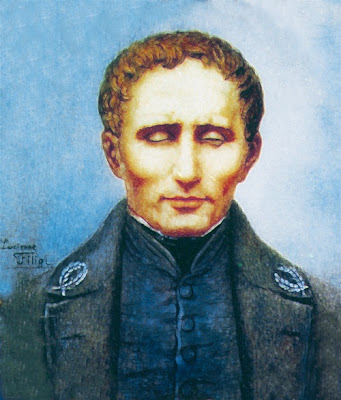 |
| Photo: A person's hand trailing a line of Braille cells |
January is National Braille Literacy Month. Braille is a tactile reading and writing system, consisting of arrangements of up to 6 raised dots representing letters, numbers, and even musical notes created by Louis Braille. Using different combinations of these dots allows for 64 different characters to be represented. It is commonly mistaken for a language; however it is simply a form of a language that can be read tactually.
 |
| Image: A portrait of Louis Braille, inventor of the Braille system |
Louis Braille was born in Coupvary, France on January 4th, 1809.
He lost his sight as a young child, commonly reported between ages 3 and 5,
after an accident with a leather working awl which resulted in infection and a
total loss of vision in both of his eyes. At age 10 he was accepted to
the National Institute for Blind Youth in Paris. At the time the school
was using books with large raised letters. Although the students could
read these books, the complexity of producing the raised letters prevented
their ability to write using this system. At age 15, inspired by a
presentation at the school by Captain Charles Barbier
of the French Army about his night writing method (a system using raised dots
and dashes allowing soldiers share information on the battlefield without
having light or needing to speak), Louis Braille had largely developed the
Braille system allowing students not only to read material but also write in a
accessible medium.
 |
| Photo: A person's index finger on the Braille noting the 'open door' button of an elevator |
Today Braille is used in a variety of ways including books, on ADA accessible
signs, menus, elevator buttons, ATMs, ticket machines, and even on some currencies.
Braille-users can read computer screens and other electronic supports thanks to
refreshable Braille displays. They can write Braille with a slate and
stylus or type it on a Braille writer, such as a portable Braille note-taker,
or on a computer that prints with a Braille embosser. Computer software
is available to translate text into Braille.
 |
| Image: A representation of the Braille Cell arrangements for letters A through Z |
Anyone can learn to use Braille, though most people who use Braille tend to be
partially sighted or blind and therefore read Braille by touch. Braille
is written using cells. Each cell compromises of 6 dots, which are either
present or left blank. Braille readers memorize the pattern of dots and the
letter that it corresponds to. There are several grades of Braille, from beginner
to advanced. Braille can be self-taught using books or the internet and
there are several free resources available.
Some benefits of being able to read Braille are:
- It allows persons to read and write print in a non-visual way.
- A wide choice of books and magazines are available in Braille.
- Braille can be used for labeling items such as food, medicine, DVDs and CDs.
- There are a variety of items available for purchase such as Braille playing cards which may enhance a person’s ability to participate in social games and activities.
- Many companies now offer newsletters and menus in Braille.
- Knowing some basic Braille could allow persons with reduced vision to access information such as elevator button numbers without the need of adequate lighting or magnification.
Braille is one of the many skills available through training at the Western Blind Rehabilitation Center. Many people choose to learn through local agency classes or using distance learning courses. Below you will find some links to resources for learning Braille and for Braille reading materials.
Courses:
CLICK HERE to learn about distance courses through HADLEY SCHOOL FOR THE BLIND
CLICK HERE to learn about courses through LIGHTHOUSE FOR THE BLIND in San Francisco
CLICK HERE to learn about courses through the SANTA CLARA VALLEY BLIND CENTER in San Jose
No comments:
Post a Comment